

| © CAMBRIDGE UNIVERSITY PRESS 1983, 1993 |
1.3 Galaxy Types
The spiral structure of our Galaxy shown in Figure 1.1 (a) was difficult to establish observationally, since we view it from within. It is easier to see structure in other galaxies, unless we are viewing them edge-on. Our nearest large galaxy, labelled M31 (see section 1.7 for the meaning of this label), in the Andromeda constellation, has a similar spiral structure (see figure 1.3). Spiral galaxies, as such galaxies are called, are probably the most numerous among the various bright galaxy types (see Figure 1.4 and 1.5). Like our Galaxy they show rotation, flattening with a central bulge, and dark lanes of absorbing matter.
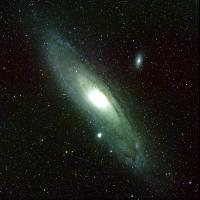
|
Fig. 1.3. The Great Galaxy in Andromeda, a spiral galaxy of type Sb. (Courtesy of Kitt Peak National Observatory.) |
In 1926 Hubble classified the various galaxy types in the following way.
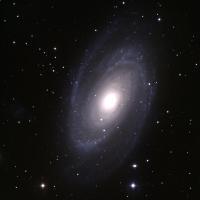
|
Fig. 1.4. Galaxy of type Sb in Ursa Major, M81 (Courtesy of Kitt Peak National Observatory. |
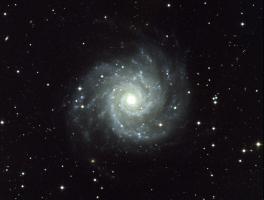
|
Fig. 1.5. Galaxy of type Sc in Pisces, M74. (Courtesy of Kitt Peak National Observatory.) |

|
Fig. 1.6. The sequence of spiral galaxy types. The shaded region represents the nucleus. |
The various classes of spiral galaxies are called Sa, Sb, Sc, and so on. The sequence is in decreasing order of the importance of the central nucleus or bulge in relation to the surrounding disc. Our galaxy and M31 are of type Sb. Some spirals have bars in the central region. These are called barred spirals and are categorized as SBa, SBb, SBc, and so on. See Figure 1.6 for schematic illustrations of these types.
While spirals are most numerous among bright galaxies, the most numerous among all galaxies are those classified as ellipticals. These are ellipsoidal in shape, show very little rotation, and have very little gas and dust (see Figures 1.7 and 1.8). The various types of ellipticals are placed in the sequence E0, E1,. . .,E7. This sequence describes progressively flattened profiles of galaxies, E0 being nearly spherical and E7 markedly flattened lenticular form. These types are illustrated in Figure 1.9.
Unlike star images, which tend to be pointlike, galaxies have nebulous shapes like those described above. Astronomers can measure the distribution of light across a galaxy with great accuracy using solid-state instruments like the charge-coupled device (CCD). The light distribution is conveniently described by isophotes, or contours of equal intensity. In many galaxies, especially the ellipticals, increasing sensitivity of measurement shows that the boundary of a galaxy does not come to an abrupt end; rather, there is a gradual diminution of intensity of light outwards from the centre. In this connection astronomers often use the so-called Holmberg radius, which corresponds to the isophote at which the surface brightness drops to 26.5 mpg (photographic magnitude) per square arc second, as some kind of observational limit to a galaxy size. (Magnitude is a measure of the brightness of a celestial object. For quantitative details see section 3.6.)
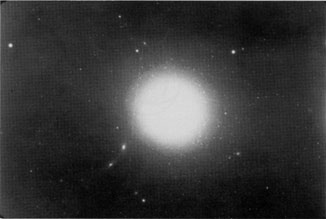
|
Fig. 1.7. Elliptical galaxy of type E0 in
Virgo, M87. Its nucleus is
believed to contain a highly collapsed mass of the order of 5 x
109 M |
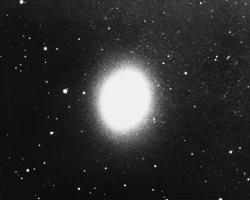
|
Fig. 1.8. Elliptical galaxy of type E2 in Andromeda, M32. (Courtesy of Kitt Peak National Observatory.) |
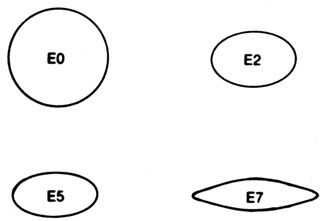
|
Fig. 1.9. The sequence of elliptical galaxy types. Not all types between E0 and E7 are shown. |
For many decades since the discovery of galaxies it was believed that they extend as far as they are visible. Thus the Holmberg radius was taken as the extent of a typical galaxy. However, in the seventies the orbits of neutral hydrogen clouds circling around a spiral galaxy indicated that the masses enclosed within them far exceeded the visible mass of the galaxy.
Figure 1.10 shows the typical rotation curve of a spiral galaxy. At a distance r from the centre O of the galaxy, a Keplerian orbit will have velocity

where M (r) is the galactic mass up to radius r from the centre. The point A represents the visible extent of the galaxy. If all the mass were visible then M (r) = constant beyond A and v should have dropped as r-1/2. In reality, v is more or less constant as far as point B, which may be two or three times farther away from O than A.
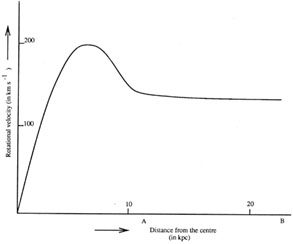
|
Fig. 1.10. The rotation curve of a spiral galaxy is flat right up to point B, well beyond the visible extent up to A. |
If Newtonian laws of gravity and mechanics hold then we have to conclude that M (r) keeps on increasing beyond A; in other words, there is unseen matter present well beyond the visible radius of the galaxy. This dark matter poses many problems for cosmological theories which we shall encounter later in this book.
Another type of galaxy, called S0, is intermediate between the ellipticals and the spirals (see Figure 1.11). Like the ellipticals, the S0 galaxies have little gas and dust, while their isophotes are more like those of the spirals (see Figure 1.12). These galaxies may have formed from collisions of spirals and ellipticals. Galactic collisions are not uncommon, especially in rich clusters of galaxies. Stars may go through a collision relatively unscathed, since they are widely spaced, but interstellar gas and dust may be spewed out into intergalactic space. In such a case the isophotes (which arise from starlight) may remain intact.
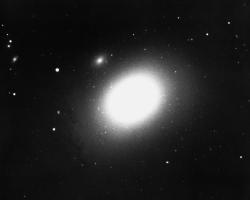
|
Fig. 1.11. Galaxy of type S0 in Virgo, M84. (Courtesy of Kitt Peak National Observatory.) |
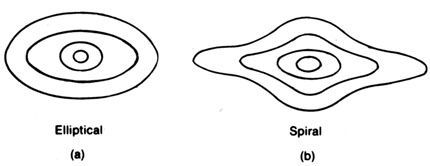
|
Fig. 1.12. The isophotes (contours of equal brightness) of an S0 galaxy are more like those of a spiral (b) than an elliptical (a). |
In addition to the types of galaxies already mentioned, there are others that are broadly classified as ``irregular''. However, some rarer species of galaxies in this group stand out because of certain special features. For example, in 1943 Seyfert investigated a class of galaxies in which the nuclei show many features common to stars, such as broad emission lines. (The spectra of galaxies as a rule show absorption lines from interstellar gas.) The Seyfert galaxies also have a large amount of infrared emission; in some cases the infrared luminosity may be as much as 100 times the visual luminosity of our Galaxy. (See Figure 1.13.)
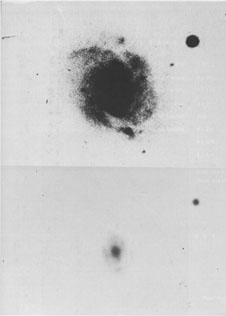
|
Fig. 1.13. Seyfert galaxy NGC 1068. The bottom picture is underexposed to show the nucleus only. (Courtesy of the Indian Institute of Astrophysics.) |
Another group of galaxies with bright nuclei like the Seyferts are the so-called N-galaxies. These galaxies emit radio waves and have large redshifts, whereas Seyferts are radio quiet and have small redshifts. (For a discussion of redshifts, see sections 1.5 and 1.8.) There is considerable similarity between Seyferts, N-galaxies, and another class of astronomical objects, the quasars (described in section 1.5).
Apart from these morphological types, galaxies are also classified by their spectral features and luminosities. W.W. Morgan introduced the formal spectral classification, while van den Bergh introduced the luminosity classes. We will not go into details of these classifications here.